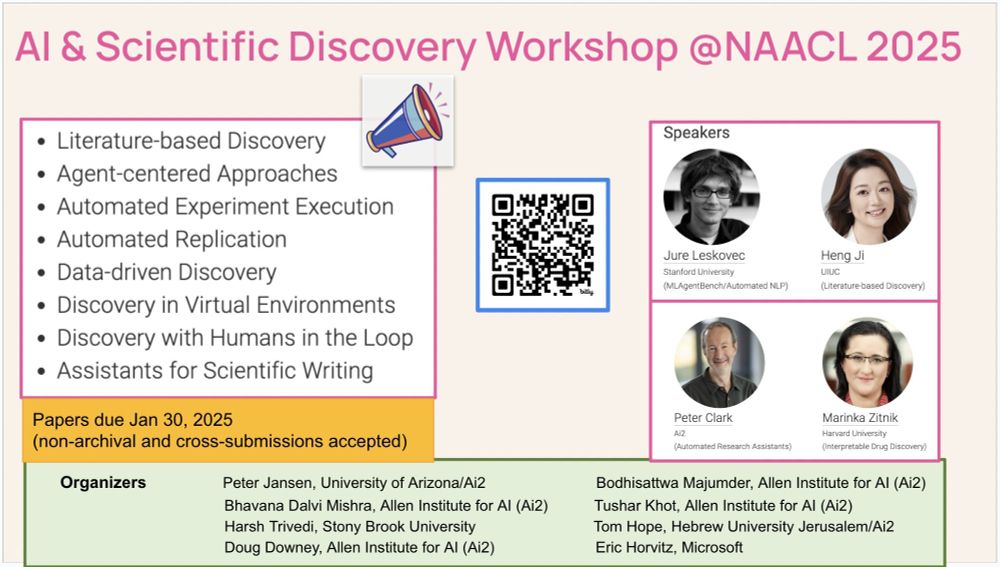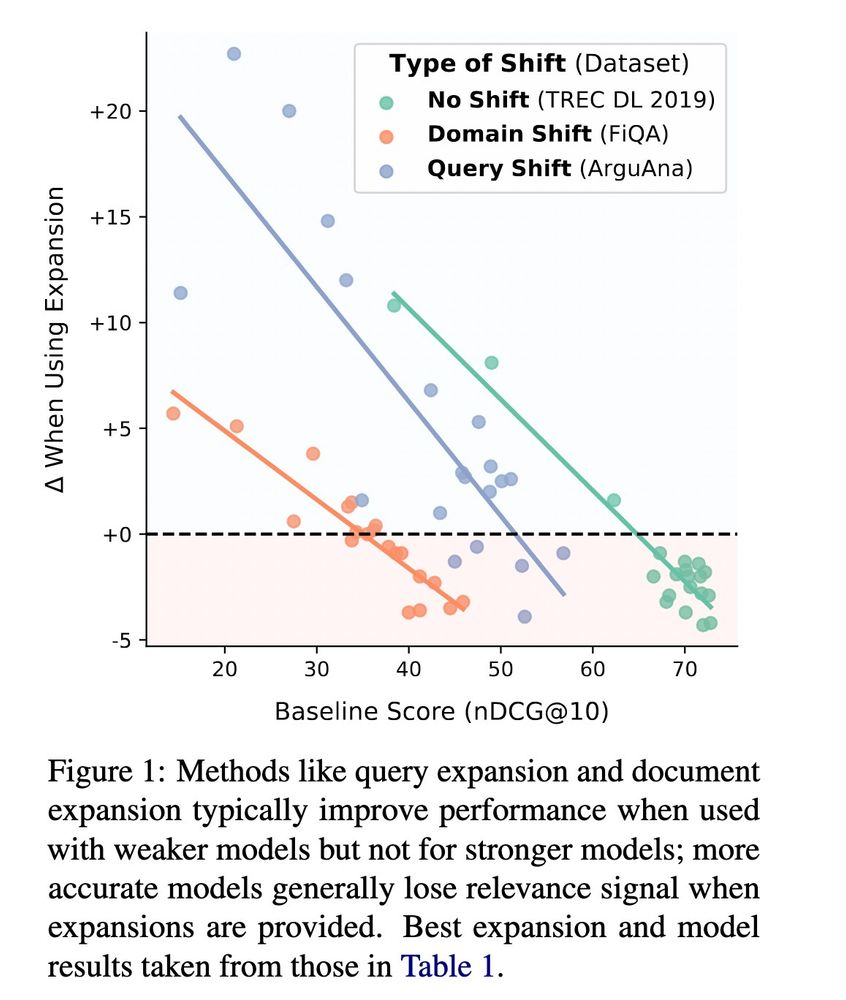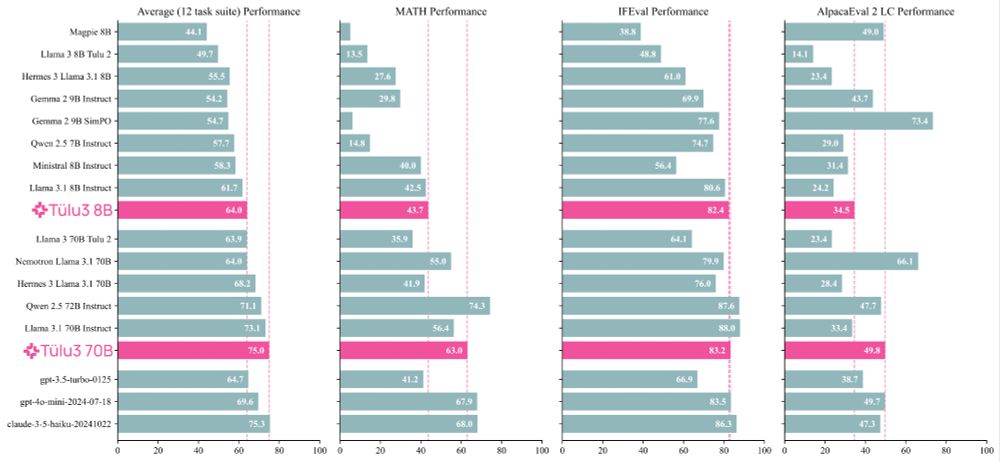
Our AI & Scientific Discovery Workshop (@ NAACL 2025) broadly welcomes papers on all aspects of the scientific discovery process through the lens of AI / NLP.
Paper submission deadline: Jan 30/2025 (about 2 weeks).
We're excited to see you there!
15.01.2025 21:08 — 👍 3 🔁 1 💬 0 📌 3
Hey Marc! Thanks for this starter pack. Can you please add me to it as well?
29.11.2024 15:57 — 👍 7 🔁 0 💬 0 📌 0

AppWorld: Reliable Evaluation of Interactive Agents in a World of Apps and People. Happening at 11 AM EST online on Dec 2, 2024
🚨 Happening next Monday, 2 Dec, @cohere.com ! ✨
👋 Anyone can join remotely at this link:
👉 cohere.com/events/coher...
🙏 Thank you @sebruder.bsky.social for helping arrange it!!
📅 Upcoming talks: appworld.dev/talks
29.11.2024 15:43 — 👍 8 🔁 1 💬 0 📌 0

A plot: the x axis is baseline score of rankers, in ndcg@10. y axis is delta of model score after an expansion is applied.
There are three sets of results, one dataset for each shift type: TrecDL (no shift), FiQA (domain shift), ArguAna (query shift). For each set of result, the chart shows a scatter plot with a trend line. We observe the same trend for all: as the baseline score increases, the delta when using expansion decreases.
On TREC DL, worst models have a base score of ~40, and improve by 10 points w/expansion. the best models have a score of >70, and their performance decreases by -5 points w/expansion.
On FiQA, worse models have a base score of ~15, and improve by 5 points w/expansion. the best models have a score of ~45, and their performance decreases by -3 point w/expansion.
On ArguAna, worst models have a base score of ~25, and improve by >20 points w/expansion. the best models have a score of >55, and their performance decreases by -1 point w/expansion.
Using LLMs for query or document expansion in retrieval (e.g. HyDE and Doc2Query) have scores going 📈
But do these approaches work for all IR models and for different types of distribution shifts? Turns out its actually more 📉 🚨
📝 (arxiv soon): orionweller.github.io/assets/pdf/L...
15.09.2023 18:57 — 👍 42 🔁 6 💬 3 📌 3
Great opportunity to see how (your) new coding agent methods stack up real world user tasks
21.11.2024 23:51 — 👍 3 🔁 1 💬 0 📌 0

Meet Tülu 3, a set of state-of-the-art instruct models with fully open data, eval code, and training algorithms.
We invented new methods for fine-tuning language models with RL and built upon best practices to scale synthetic instruction and preference data.
Demo, GitHub, paper, and models 👇
21.11.2024 17:15 — 👍 111 🔁 31 💬 2 📌 7
another starter pack, this time for folks (past & current) from Ai2 (@ai2.bsky.social) 😍
go.bsky.app/Qjyc97J
21.11.2024 16:10 — 👍 22 🔁 5 💬 2 📌 0
I thought to create a Starter Pack for people working on LLM Agents. Please feel free to self-refer as well.
go.bsky.app/LUrLWXe
#LLMAgents #LLMReasoning
20.11.2024 14:08 — 👍 15 🔁 5 💬 11 📌 0
🚨 We are refreshing the 🌎 AppWorld (appworld.dev) leaderboard with all the new coding and/or tool-use LMs.
❓ What would you like to be included?
🔌 Self-plugs are welcome!!
x.com/harsh3vedi/s...
21.11.2024 14:11 — 👍 7 🔁 2 💬 0 📌 1
Hi Nikolai! Mind adding me to this starter pack? Thanks!
21.11.2024 13:05 — 👍 1 🔁 0 💬 1 📌 0
Hi! Can you please add me to this list? Thank you!
18.11.2024 22:56 — 👍 1 🔁 0 💬 0 📌 0
Hi Michael! Can you please add me to this list? Thank you!
18.11.2024 22:55 — 👍 2 🔁 0 💬 0 📌 0
Hi Maria! Can you please add me to the list? Thank you!
18.11.2024 22:53 — 👍 0 🔁 0 💬 0 📌 0
@_angie_chen at the other place
PhD student @NYU, formerly at
@Princeton 🐅
Interested in LLMs/NLP, pastries, and running. She/her.
Assist. Prof.@OhioState, co-director OSU NLP. I like to think about intelligence and manifest it into language agents
Assist. Prof at CMU, CS PhD at UW. HCI+AI, map general-purpose models to specific use cases!
Visiting Scientist at Schmidt Sciences. Visiting Researcher at Stanford NLP Group
Interested in AI safety and interpretability
Previously: Anthropic, AI2, Google, Meta, UNC Chapel Hill
PhD supervised by Tim Rocktäschel and Ed Grefenstette, part time at Cohere. Language and LLMs. Spent time at FAIR, Google, and NYU (with Brenden Lake). She/her.
PhD student at JHU. @Databricks MosaicML, Microsoft Semantic Machines/Translate, Georgia Tech. I like datasets!
https://marcmarone.com/
Research Scientist at Meta • ex Cohere, Google DeepMind • https://www.ruder.io/
We build secure, scalable, and private enterprise-grade AI technology to solve real-world business problems. Join us: http://cohere.com/careers
PhD Candidate at UC Irvine, Research Intern @ai2 | Previously ASAPP Amazon LinkedIn @msftresearch IIT-Delhi
Research on In-Context Learning and LLM Agents
https://shivanshu-gupta.github.io
Research centre for the study of corpus linguistics and corpus-based natural language processing at Lancaster University
T: +44 1524 510357
E: ucrel@lancaster.ac.uk
W: https://ucrel.lancs.ac.uk/
Y: https://www.youtube.com/@ucrelcrs8222
Senior Research Scientist at Google DeepMind
https://swarooprm.github.io/
ML @ Microsoft. Previously at Google Research. Probably approximately correct.
CS PhD student at USC. Former research intern at AI2 Mosaic. Interested in human-AI interaction and language grounding.
Professor at UW; Researcher at Meta. LMs, NLP, ML. PNW life.
Researcher in NLP/IR at the University of Sheffield, Research interests include Conversational AI, RAG and other topics among NLP/IR.
Ph.D. Student at UNC NLP | Prev: Apple, Amazon, Adobe (Intern) vaidehi99.github.io | Undergrad @IITBombay
The AI developer platform.
Senior Director, Research Scientist @ Meta FAIR + Visiting Prof @ NYU.
Pretrain+SFT: NLP from Scratch (2011). Multilayer attention+position encode+LLM: MemNet (2015). Recent (2024): Self-Rewarding LLMs & more!



